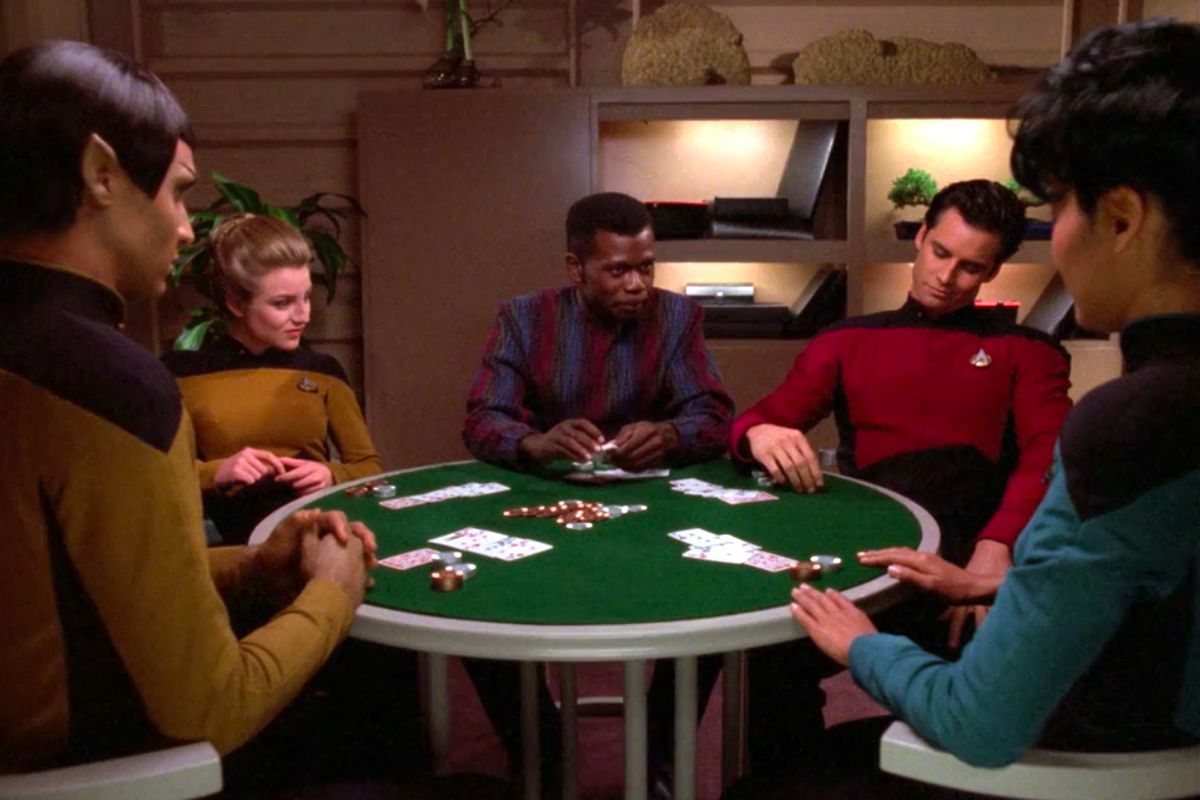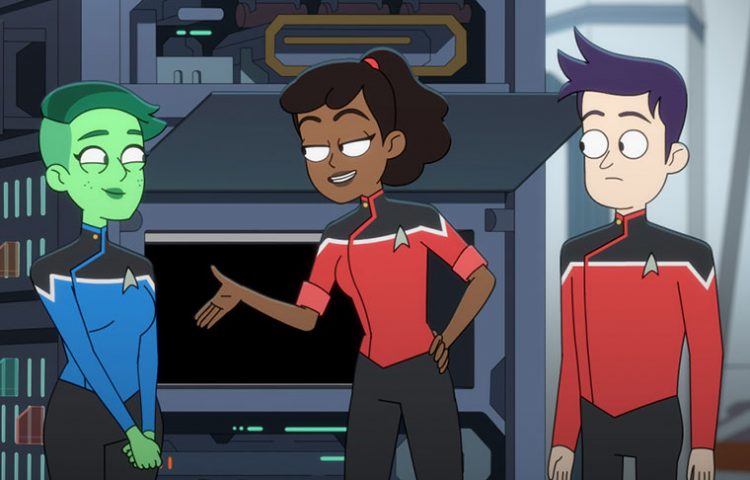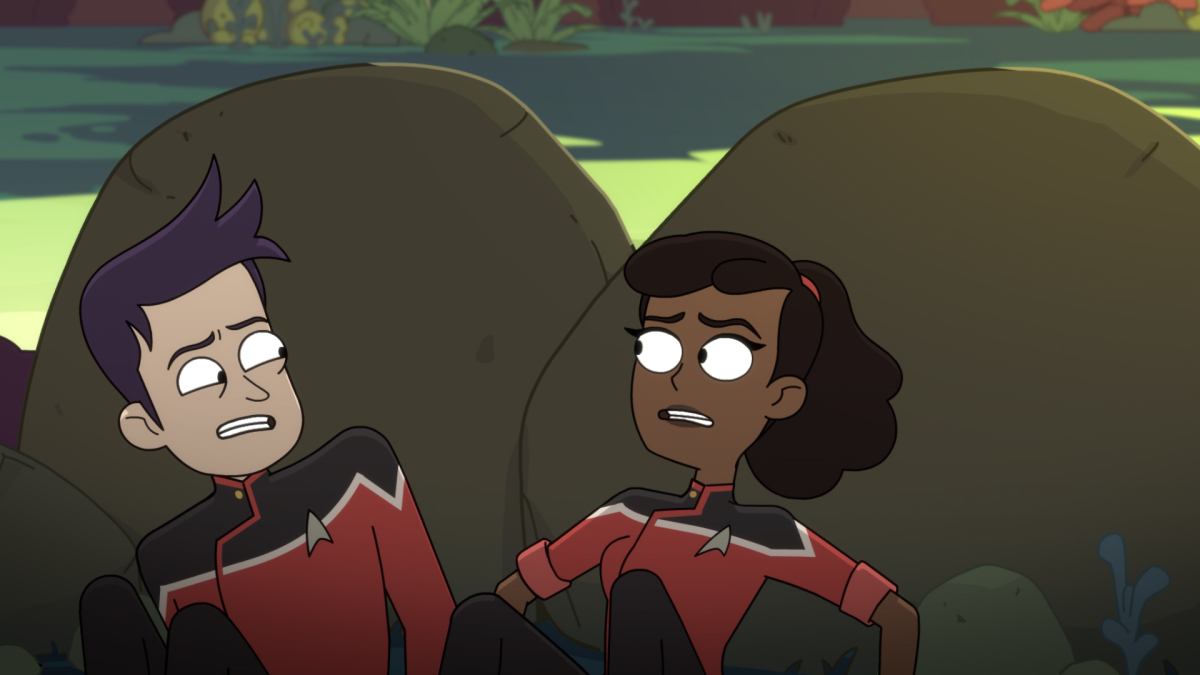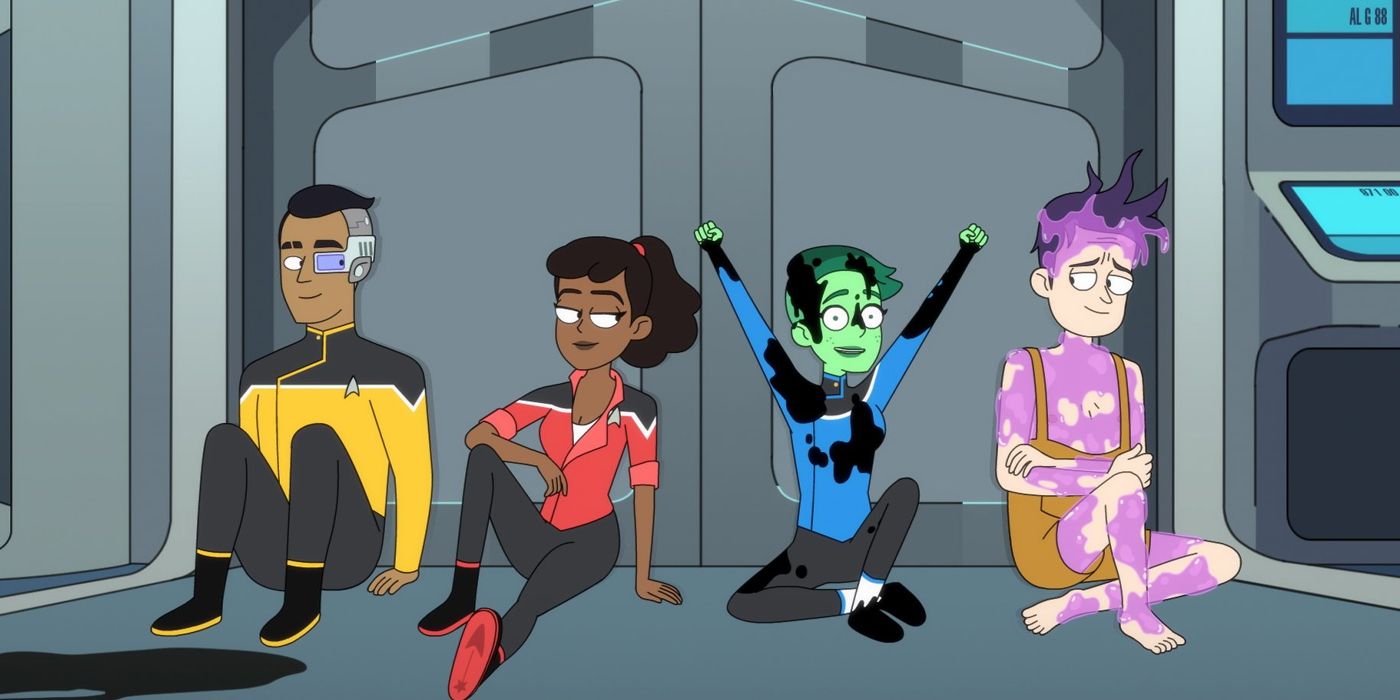*This post contains full spoilers for the first episode of Star Trek: Lower Decks.
Star Trek: The Next Generation – “Lower Decks” (season 7, episode 15)

Teleplay by Rene Echevarria; Story by Ron Wilkerson & Jean Louise Matthias; directed by Gabrielle Beaumont; first aired in 1994
We open in Ten Forward, where Counselor Troi and Commander Riker are working on crew evaluations … and where Ensigns Sito, Ogawa, Lavelle, and Taurik sit on the other side of the lounge, as waiter Ben goads them with gossip about who’s up for promotion. From here, the episode mostly follows these “lower deck” officers, as Sito and Lavelle train for bridge postings; Ogawa discusses her relationship worries with her supervisor, Dr. Crusher; Taurik shares his ideas for improving efficiency in Engineering with his own supervisor, an irritated LaForge; and Ben, the easygoing civilian, serves as our link between the upper and lower decks. But as everyday life on the Enterprise plays out for these younger, greener officers, we get hints here and there of what would be the A-story of this episode on a normal week: Joret Dal, a Cardassian military officer and Federation operative, has covertly crossed the border to deliver vital intelligence, and now needs help returning safely to Cardassian space … which means he needs a Bajoran to pose as his prisoner, so he can claim to be a bounty hunter. Ensign Sito is Bajoran, and after being berated by Picard for her shady history at Starfleet Academy – and after being encouraged by her mentor, Worf, to stick up for herself and not let her past define her – Sito learns that Picard was in fact testing how she would react under stress, to determine whether she was ready for this dangerous covert mission. (She also learns that Picard asked that she be assigned to the Enterprise, where she wouldn’t be judged unfairly for her past.) Sito volunteers to help Joret, despite her people’s history of oppression under the Cardassians; as they cross the border in a “stolen” Starfleet shuttle, she asks Joret why he would help the Federation, and he insists that he believes in the Cardassian military, but that they’ve been led astray, and that he’s “tired of war” – something Sito never believed she would hear from a Cardassian. This is the last we see of Sito, and later, aboard the Enterprise, we learn that she was successful in her mission to get Joret home safely … but was killed by a Cardassian patrol on her own way home. As her friends from the lower decks mourn her in Ten Forward – and as Lavelle reveals that he got that promotion to a bridge posting, which probably would have been Sito’s if she had lived – Ben encourages Worf to join them, so the people closest to Sito can mourn her together.
VS.
Star Trek: Lower Decks – “Second Contact” (season 1, episode 1)

Written by Mike McMahan; directed by Barry J. Kelly; first aired in 2020
We open on voice-over of a log entry explaining the mission of the USS Cerritos, which specializes in second contact (taking care of the sorts of post-first-contact bureaucratic details we never saw the Enterprise have to deal with) under the command of Captain Freeman. This “captain’s log,” though, is actually being recorded by captain’s pet Ensign Boimler, until the free-spirited Ensign Mariner catches him, and mocks him. When Ensign Tendi, an idealistic Orion, is transferred to the Cerritos, Mariner and Boimler show her around the ship and introduce her to Ensign Rutherford, a recently-enhanced cyborg who is nervous about his upcoming date with Ensign Barnes. Mariner and Boimler are assigned to help build a communications array on a newly-contacted planet, and Captain Freeman orders Boimler to spy on Mariner, and report back if he observes her breaking protocol … the way she has been doing for pretty much the entire episode so far. While Boimler does this – and finds Mariner giving stolen farming equipment to the locals, instead of making them wait for the proper paperwork to go through – the Cerritos’ first officer, Commander Ransom, brings a zombie-like infection aboard the ship. Rutherford and Barnes have their date in the ship’s lounge, and continue to get to know each other better as a zombie apocalypse rages all around them. As Boimler and Mariner go through the disgusting process of helping the local farmers track down their spider-like livestock, they argue about whether senior Starfleet officers are heroes or glory-hounds, and finally beam back aboard the Cerritos only to end up in the middle of a dramatic fight against the zombified crew. Luckily, Boimler is covered in spider-goo which the ship’s chief medical officer, Dr. T’Ana, can use to cure the zombie virus. Hearing Captain Freeman record a captain’s log in which she gives all credit to T’Ana, and none to him, Boimler covers for Mariner – who we finally learn is the captain’s daughter – and later admits to Mariner that Starfleet is better with her in it.

Star Trek, like a lot of things, is built on a contradiction. (I mean, it’s probably built on a few contradictions, but we’ll just focus on the one for now.) The Original Series established Star Trek as being about the best and brightest of future humanity heroically spreading their enlightened awesomeness across the galaxy. Virtually all the Trek that’s come since has at least been in conversation with that concept, and has tended to ultimately embrace it; even Deep Space Nine, Enterprise, and Picard, while willing to look critically at Starfleet’s role in the galaxy, all still narratively mirror Starfleet’s command structure by mainly following a commanding officer (or at least a former commanding officer, in Picard’s case) and their senior staff. But an equally important part of Star Trek’s appeal has long been the escape it offers its audience, from the flawed, unfair world we live in, into a future that accepts everyone, and treats them the way we might wish our world treated us, and those around us. This element of utopian escapism was usually either implied or vaguely alluded to in The Original Series, but was officially codified in The Next Generation, in which we’re explicitly told that the Earth and United Federation of Planets of the 24th century comprise a perfect paradise, in which “the acquisition of wealth is no longer the driving force in our lives,” and in which humans “work to better ourselves and the rest of humanity,” according to that space-dad to many an 80s kid, Jean-Luc Picard himself. Imagining this life for ourselves is, I think, a big part of what keeps many a Trek fan coming back to this fictional universe … and it seems a bit at odds with the format of a typical Trek episode, so tightly focused on the best-of-the-best bridge crew. Speaking purely for myself here, while I grew up admiring those heroes of Starfleet senior staff, I haven’t always been able to relate to them, or to easily imagine myself among them. And isn’t part of the point of Star Trek that we shouldn’t need to? That there’s a fitting place in its future for everyone, and not just for the elite, type-A chosen ones?

Later series of Star Trek would invest at least some of their energies in further exploring those seemingly less heroic lives, lived far from the bridge: most notably Deep Space Nine, through its setting on a grimy, run-down, politically complex space station, or Discovery, by closely following the court-martialed Michael Burnham as its central POV character, regardless of her rank or position. But Star Trek’s newest TV series (as of the time I’m writing this, at least) is the first to mainly focus on those who haven’t earned a prestigious Starfleet bridge posting, and it takes its name, quite appropriately, from an episode of The Next Generation which was one of the franchise’s early experiments in exploring the lives of the less-elite. “Lower Decks,” the episode, first aired midway through TNG’s seventh and final season, at a time when the series was comfortable enough with its own rules to bend them in ways that produced some of Star Trek’s most unapologetically weird episodes, giving us Counselor Troi as a living cake in “Phantasms,” Reg Barclay as a giant spider in “Genesis,” and Dr. Crusher being haunted by a candle-dwelling sex-ghost in “Sub Rosa.” But it was this same experimental gutsiness that made “Lower Decks” one of Star Trek’s finest and most self-aware moments, taking the sort of background characters who might normally get one or two lines of dialogue here and there (including Ensign Ogawa, who really had been exactly that background character in several earlier episodes of TNG) and making them as important, for those 45 minutes or so, as Worf or LaForge or Picard himself.

We’d seen a similar slice of life aboard the Enterprise-D in “Data’s Day,” a few seasons earlier, complete with the more typical TNG A-story unfolding mostly in the background while the B- or C-story gets its time in the spotlight. But where “Data’s Day” softens this surprising departure from formula by centering it around a widely beloved main character, “Lower Decks” knocks the audience even further off-balance by having us spend most of our time with characters we’ve rarely, or never, even seen before; and while “Data’s Day” keeps its tone lightly comedic for most of its running time, “Lower Decks” trusts us to become so emotionally invested in these largely unknown characters that its tragic ending is among the saddest moments in all of Star Trek. Lower Decks the series, of course, takes a tone more in line with that of “Data’s Day,” as the first Trek TV series to be billed explicitly and primarily as a comedy. But like the episode “Lower Decks,” the series Lower Decks still asks us to take its not-so-obviously-heroic characters seriously enough to become invested in them, and to keep coming back to spend time with them while more traditional Starfleet heroes drift in and out of the background. And where the backgrounded A-story of “Data’s Day” feels (by design, I think) like a boilerplate Trek plot that could have been cut-and-pasted from pretty much any episode of any Star Trek series, both the episode “Lower Decks” and the Lower Decks series premiere, “Second Contact,” are set against the backdrop of an upper-deck problem which highlights how separate those upper and lower decks really are.

In the episode “Lower Decks,” that backgrounded A-story – a mission to protect, and preserve the cover of, an informant from the fascistic Cardassian military – is unmistakably reminiscent, in The Next Generation’s final season, of other espionage-and-intrigue episodes from earlier in the series, like “The Defector,” “Face of the Enemy,” and “Data’s Day” itself. But where such episodes of TNG had tended to focus on the Romulan Empire as a long-established source of Cold War-like political tension in the Star Trek universe, “Lower Decks” shifts that focus to the Cardassians, another authoritarian empire which was introduced in TNG’s later seasons and went on to play a central role throughout Deep Space Nine, as the perpetrators of a recently-ended, decades-long military occupation of the planet Bajor, and of all the atrocities that occur under such an occupation. Much like moving the spotlight from our core characters to this episode’s cast of junior officers, setting this story against the backdrop of conflict with the Cardassians is an important, impactful choice. While the Romulans certainly had their moments in The Next Generation – “The Defector,” in particular, is one of my favorite episodes in all of Trek – I don’t think they ever quite gelled as the “big bad” that the show’s writers seemed to want them to be. The Romulans only appeared a couple of times in The Original Series, but when they did, in “Balance of Terror” and “The Enterprise Incident,” their presence was made personal through the audience’s attachment to Spock, who, being half human and half Vulcan, had to reckon with the political implications of looking very much like these feared enemies of the Federation, and with the troubling knowledge that those enemies inherited their warlike ways from his own people. Without Spock, the Romulans couldn’t quite be that personalized threat and subject of redemption. But the Cardassians could, through the introduction of Bajoran occupation survivors like Ensign Ro, Deep Space Nine’s Major Kira … and Ensign Sito, who first appeared on TNG as part of a Starfleet Academy coverup in “The First Duty,” and makes her inspired final appearance here, in “Lower Decks.”

Which is what this episode is all about: reminding us that everyone, not just the best-of-the-best bridge crew, has a stake in Star Trek’s luxury space-socialist future … and that everyone is integral to that future. We’re shown this through each of the lower-deck characters: Taurik reminds us that even an overeager junior officer can sometimes see things that even an experienced upper-deck officer might miss; Lavelle reminds first officer Riker that he himself once was that eager-to-please new officer; Ogawa reminds us that the crew members we see only briefly, every now and then, have their own personal lives that don’t stop when the plot no longer needs them to hand a PADD to a main character; and Ben, the beloved waiter we’ve never seen before, reminds us of the sheer scope of life that takes place aboard the mobile city in space that is the Enterprise, the sheer number of people aboard with lives, responsibilities, and relationships of their own. But of course, it’s Sito who really drives that point home, as the lower-deck character with the deepest backstory, the most to prove, and, ultimately, the most to lose. We’re shown the impact that a typical TNG problem of the week could have on all these lower-deck characters, as the plot unfolds mostly from their point of view, keeping them – and us – uncomfortably in the dark until late in the episode, not privy to the plot details we would see unfolding over the course of a more typical episode. But once we finally are let in on what’s going on, from Sito’s perspective, the focus shifts to her position not only as one of the grunts that make Starfleet possible, but as a person who has lived through exactly the sort of cruelty and horror that make us hope for the kinder, gentler future of the Federation.

And as a representative of that Federation, now, she embodies its principles by risking her life for someone who would have been her mortal enemy a few years earlier. “Lower Decks” shows its confident, final-season restraint in the subtlety with which it handles Sito’s final scenes; there is no exposition dump on the history of the Cardassian occupation of Bajor, and we hear no stories from Sito of her own experiences during that time. Instead, a single line, delivered to the Cardassian Joret’s face during Sito’s briefing, is allowed to carry the weight of all that backstory: “I’m Bajoran – no one knows better than I do what Cardassians do to their prisoners.” And that impact is only amplified by this line from Joret, after Sito has left the conference room: “I didn’t realise she would be so young.” Everyone has a stake in building and maintaining the sort of just society the Federation represents, because everyone suffers, one way or another, when that societal justice fails. We see this in another near-perfect scene shortly thereafter, in a conversation between Joret and Sito on board their shuttle, during which the fake but gruesome bruises Sito wears as part of her “bounty-hunted Bajoran” disguise only serve to hammer home the brutality of Bajoran oppression at the hands of the Cardassian military – as does Joret’s advice that Sito should act like he has “broken [her] will,” and act “afraid to answer” any questions Cardassian border officials might ask her. She asks Joret himself a question:
Sito: Can I ask you something? Why are you doing this, risking your life to help Starfleet?
Joret: I don’t consider myself a traitor, if that’s what you’re asking. All my life I’ve served in the military. Once, it was an institution dedicated to the security of Cardassia. Now, it’s little more than a platform for ambitious Guls hoping to make their reputations in battle. If the information I provided helps Starfleet deter even one pointless skirmish, I’ve served my purpose. I’m sick of war. My people need peace.
Sito: I never thought I’d hear a Cardassian say something like that.
Joret: And I never thought a Bajoran would risk her life to help a Cardassian get home.
I don’t think we know Joret’s rank – and he’s probably not exactly from the lower decks himself, if he has access to sensitive tactical information – but his position here still somewhat mirrors Sito’s, as a cog in a larger machine, but making an oversized contribution to building a more just society. And when we cut from that scene (Sito’s last) back to the Enterprise, the bridge crew are finally put in that lower deck position themselves, as they wait helplessly for information on Sito’s whereabouts … and as Lavelle, needing otherwise classified information in order to carry out his duties, is let into that loop, putting upper and lower decks on equal footing. It’s a fitting message from an episode of Star Trek, and especially from one of The Next Generation’s last few episodes: Star Trek’s better future is one in which no one is expendable, everyone is included and valued, everyone is essential.

Lower Decks, the series, obviously takes a very different tone to “Lower Decks,” the episode … but the themes of its first episode, “Second Contact,” are not actually all that different. As we’re told immediately by Ensign Boimler’s opening “captain’s log” – and by the episode title itself – the Cerritos is an entire ship devoted to doing the sort of behind-the-scenes busywork we so rarely saw done by the Enterprise (or the Voyager, or the Discovery, or those other Enterprises, either). First contact with new life is dramatic and exciting, but a well-functioning society like the Federation isn’t built on drama and excitement alone. It would, if it were real, be built on a whole lot of busywork, on a whole series of steps that we haven’t traditionally seen taken in Star Trek, because they might not make for the most exciting television. It’s one thing for Captains Kirk or Picard to breeze in and solve some new civilization’s problem of the week, but … then what happens? Second contact, that’s what, and the idea is an obvious source of comedy in the vein of everyday-stakes sitcoms like The Office or Parks and Recreation, as well as a chance for a long-running franchise to poke some self-aware fun at itself. But it’s also an opportunity for that franchise to semi-seriously take stock of itself, and to fill in some of the sociopolitical gaps in its fictional universe that have become more and more apparent over the decades. Kirk completely upending an alien culture and trusting the details to magically work themselves out after he leaves, in episodes like “A Taste of Armageddon” or “The Gamesters of Triskelion,” might have worked in the context of The Original Series, which was presented to its original audience more as an anthology of sci-fi short stories than as an ongoing series (at least in the way we tend to use those terms today). But as Star Trek has become both a fleshed-out fictional universe and an influential entertainment empire, the implications of this casual colonialism have become harder and harder to ignore … as has the fact that most Trek TV series have asked us to take the Federation’s utopian perfection as a given, while showing us hardly any of the heavy lifting required to build and maintain such a paradise.

In “Second Contact,” Lower Decks already finds, in that heavy lifting, both a source of comedy and a fresh perspective on Star Trek. The comedy, while never falling entirely flat for me, could stand to be punched up a bit (as it has been, in my opinion, in subsequent episodes), aside from a few standout moments here. (This episode’s funniest line, by far, comes from Ensign Mariner: “I have served on five ships, man. I have seen stuff. One time, I got trapped in a sentient cave for weeks. You ever been trapped in a sentient cave? That’s a dark place that knows things.”) But that new perspective is already intriguing here. Like the Next Generation episode “Lower Decks,” “Second Contact” shows us that whatever A-plot-ready adventures the upper-deck officers get themselves into – even on the far-from-a-flagship Cerritos – life goes on for the lower-deck grunts, who also have an integral role to play in those adventures; we see Rutherford and Barnes make casual first-date small talk throughout the ship-wide zombie apocalypse, and we see that zombie apocalypse (which was carelessly caused by upper-deck Commander Ransom) being cured only thanks to the alien goo brought aboard (also accidentally) by lower-deck Boimler. But unlike TNG, Lower Decks is willing to challenge the structure of Starfleet and the Federation as it has typically been presented to us. Boimler can only bring that life-saving goo onto the Cerritos because of Mariner’s off-the-books arrangement with the local aliens, bypassing second contact procedures to get their farmers the supplies they need without the delay of Federation formalities. Seeing Mariner break Starfleet’s rules to help someone, and not just for fun – and learning, at the episode’s end, that she’s the child of a Starfleet family, stationed on her mother’s ship – recontextualizes her rebellion against authority. Having grown up in and around Starfleet, having “seen stuff,” has taught her that Starfleet isn’t as perfect as we’ve been told (but rarely shown), and has put her in the position to do something about that, here and there, by ignoring the letter of the law in order to preserve its spirit. And Boimler, the ultimate rule-follower, finally sees that there is a place in Star Trek’s future for the “chaotic good,” and not just the “lawful good,” when he concludes that “Starfleet is better with [Mariner] in it.”

Excellent post! I hopes this means you’re going to be around a little more often and grace us with more of your wonder essays!
LikeLiked by 1 person